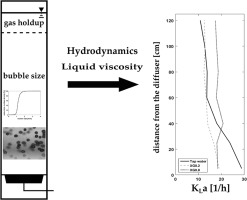Water Research ( IF 11.4 ) Pub Date : 2017-11-03 , DOI: 10.1016/j.watres.2017.10.062 Andreia Amaral , Giacomo Bellandi , Usman Rehman , Ramiro Neves , Youri Amerlinck , Ingmar Nopens

|
Aeration is the largest energy consumer in most water and resource recovery facilities, which is why oxygen transfer optimization is fundamental to improve energy efficiency. Although oxygen transfer is strongly influenced by the bubble size distribution dynamics, most aeration efficiency models currently do not include this influence explicitly. In few cases, they assume a single average bubble size. The motivation of this work is to investigate this knowledge gap, i.e. a more accurate calculation of the impact of bubble size distribution dynamics on oxygen transfer. Experiments were performed to study bubble size distribution dynamics along the height of a bubble column at different air flow rates for both tap water and solutions that mimic the viscosity of activated sludge at different sludge concentrations. Results show that bubble size is highly dynamic in space and time since it is affected by hydrodrynamics and the viscosity of the liquid. Consequently, oxygen transfer also has a dynamic character. The concept of a constant overall volumetric oxygen transfer coefficient, , can thus be improved. A new modeling approach to determine the locally based on bubble size distribution dynamics is introduced as an alternative. This way, the for the entire column is calculated and compared to the one measured by a traditional method. Results are in good agreement for tap water. The modeled based on the new approach slightly overestimates the experimental for solutions that mimic the viscosity of activated sludge. The difference appears to be lower when the air flow rate increases. This work can be considered as a first step towards more accurate and rigorous mechanistic aeration efficiency models which are based on in-depth mechanism knowledge. This is key for oxygen transfer optimization and consequently energy savings.
中文翻译:

通过了解气泡尺寸分布动力学来提高建模通气效率的准确性
在大多数水和资源回收设施中,曝气是最大的能源消耗者,这就是为什么氧气转移优化对提高能源效率至关重要。尽管氧气的传输受到气泡尺寸分布动力学的强烈影响,但是大多数曝气效率模型目前并未明确包括这种影响。在少数情况下,它们假设单个平均气泡大小。这项工作的动机是研究这种知识差距,即更准确地计算气泡尺寸分布动力学对氧气传输的影响。进行实验以研究自来水和模拟活性污泥在不同污泥浓度下的粘度的溶液在不同空气流速下沿气泡塔高度的气泡尺寸分布动态。结果表明,气泡大小在空间和时间上是高度动态的,因为它受流体动力学和液体粘度的影响。因此,氧转移也具有动态特性。恒定的总体积氧气传输系数的概念,因此可以改善。一种新的建模方法来确定引入基于气泡大小分布动态的局部方法作为替代方法。这样,计算整个色谱柱的色谱柱,并与通过传统方法测得的色谱柱进行比较。自来水的结果非常吻合。建模 在新方法的基础上,高估了实验 用于模拟活性污泥粘度的溶液。当空气流量增加时,差异似乎较小。可以将这项工作视为迈向建立基于深入机械知识的更准确,更严格的机械曝气效率模型的第一步。这是优化氧气传输并因此节省能源的关键。











































 京公网安备 11010802027423号
京公网安备 11010802027423号